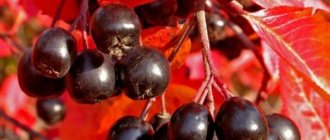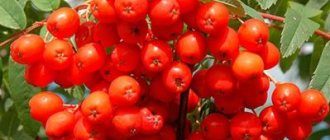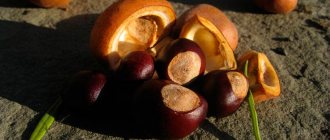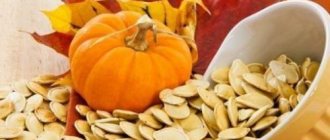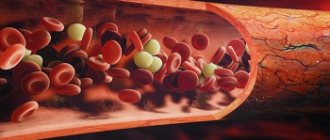- 31.10.2017
- Glycemic index, Health, Nutrition, Articles, Explanatory
The beneficial and nutritional properties of pumpkin are well known throughout the world. More than 5 thousand years ago, the vegetable was cultivated by the Indians and was brought to Russia in the 16th century from Southern Mexico. The vegetable is used in the preparation of various dishes with different methods of heat treatment; the glycemic index of raw and boiled pumpkin is different.
Glycemic index of pumpkin
The glycemic index is a coefficient that shows how much a food affects the concentration of sugar in the blood. For all products, it is compared with the glycemic index of pure glucose, which is 100, this is the maximum possible indicator.
Pumpkin has a glycemic index of 75 - this is a high indicator, which means that it should be consumed in very small quantities, no more than once a week.
This indicator practically does not depend on culinary processing, although pumpkin is eaten boiled, baked, and sometimes even fried. The glycemic index is usually indicated for boiled or baked pumpkin, since it is not eaten raw.
Mechanism of type 2 diabetes
Diabetes mellitus syndrome is observed in a number of endocrine disorders. One of the others is type 2 diabetes. Its symptoms are similar to those of other forms, but the mechanism of formation is noticeably different.
The absorption of glucose includes several stages:
- carbohydrates from food are digested and broken down into glucose, galactose and fructose. Sugar is released into the blood and blood glucose levels rise;
- the pancreas produces insulin, the hormone affects the receptors of insulin-dependent cells;
- Based on the signal from the receptors, membrane permeability increases and transport proteins are produced. With their help, glucose enters the cell. As sugar is absorbed, its level in the blood decreases to normal;
- Some of the glucose is transformed into glycogen and stored in the liver and muscles. This substance is used to restore the indicator during hyperglycemia.
In type 2 diabetes, the pancreas regularly produces insulin, but the sensitivity of cell receptors is so low that the permeability of the membranes does not change even with high doses of the hormone. Accordingly, glucose still does not get inside and remains in the blood. Moreover, the part that should be stored in the form of glycogen is broken down at a rate 3 times higher than normal, that is, it maintains hyperglycemia.
To regulate sugar levels in this state of affairs, it is necessary, first, to consume foods that do not provoke the release of large amounts of sugar. Pumpkin is such a product for diabetes.
Useful properties of pumpkin
Pumpkin contains a wide variety of vitamins - A, C, group B, PP and others. They have a variety of positive effects on the body.
In addition, it contains microelements:
- Iron, involved in hematopoiesis and other important processes in the body;
- Magnesium, necessary to maintain the functioning of nervous tissue and normalize heart rhythm;
- Potassium, necessary to maintain acid-base balance, heart rhythm, kidney and pancreas function;
- Calcium, which strengthens bones, is involved in muscle contraction.
These substances are contained in pumpkin in large quantities, sometimes even exceeding the daily human requirement.
- Low fat content, mostly polyunsaturated, which does not increase blood cholesterol, as well as protein, the composition of which is quite close to complete.
- Additionally, the high water content makes pumpkin low in calories. Thus, this product becomes a tasty and healthy addition to food.
However, the high glycemic index of baked or otherwise prepared pumpkin is a consequence of its high glucose content.
Common sweeteners
Of the natural intense sweeteners that are commercially available, stevioside is actively used in practice. In terms of sweetness, it exceeds sucrose by 300–450 times. Other sweeteners can be 5000 or 6000 times sweeter than sucrose, but in real practice they are not as in demand as stevioside.
One of the serious advantages of this sweetener is the absence of side effects. Moreover, stevioside is credited with a huge number of medicinal effects. However, it has not yet been possible to confirm at least one of them, since there is no theoretical basis.
Another thing is that this polyol contains a set of glucosides that give it a salty taste. Because of this feature, stevioside is added to a limited number of dishes (mainly fish, salads).
Stevia was brought to the European and North American market by the biologist and ethnographer, linguist Bertoni Moises Santiago, a famous Swiss anarchist who fled from persecution by the authorities to Argentina (1884) with the goal of creating an agricultural commune. As the director of an agronomic college in the capital of Paraguay, Asunción, he became interested in stories about the extraordinary sweet-tasting stevia plant. He was able to finally identify and describe the type of plant only 12 years later, having received a living specimen as a gift from a priest in 1903.
Currently, Russian manufacturers import the sweetener stevioside from China and India. It is believed that the yield of steviazide from their raw materials is much higher. Also, according to economic calculations, it is much more profitable to export a product from these countries than to produce it from our own raw materials.
Due to the high cost of stevioside, it is most often used in combination with some kind of sweetener, for example synthetic sucralose, or sweeteners sorbitol and xylitol. In this way, it is possible to add volume to the final product so that the consumer does not feel a significant difference with sugar - not adding it to tea at the tip of a knife, but pouring a full teaspoon.
Leaders among artificial sweeteners
Of the artificial sweeteners, it is worth highlighting the four most common: the most popular is saccharin, then acesulfame potassium, sodium cyclamate, and aspartame.
Most manufacturers import these sweeteners from China. China's products are considered inexpensive raw materials for tabletting. The quality of these nutritional supplements is also considered good.
The oldest sweetener, saccharin, was used on a large scale in the food industry during World War II, when there was a catastrophic shortage of sugar. However, in the 70s. last century, after experiments on Wistar rats, this sweetener was attributed to a negative effect on the human body - provoking cancer of the urinary tract (bladder, ureter). Saccharin was instantly blacklisted. Some time later he was acquitted. Currently, saccharin is approved for use in more than 90 countries. An analysis of statistics on the incidence of urinary tract cancer in the war and post-war years, for example in Germany or the USSR, did not show any surge in the suspected disease. Most likely, this was some kind of marketing ploy.
There are also cautions regarding limiting the use of other common sweeteners, such as acesulfame potassium. It is not recommended for patients with cardiovascular diseases and kidney diseases. However, no evidence-based publications on this matter could be found.
Acesulfame potassium is mainly used in the manufacture of beverages, dairy products, confectionery, and table sweeteners. It dissolves quickly in water, making it well suited for instant drinks and tabletop sweeteners. Combines well with other sweeteners, such as aspartame. In the mixture, the sweetness of acesulfame potassium is felt instantly, but does not last long. Aspartame is responsible for the long-lasting sweet taste. Its sweetness is not immediately felt, but it lasts longer. By mixing these substances in different proportions, it is possible to select the optimal sweetness for any food product.
Aspartame is the most consumed sweetener in the world by volume. Most carbonated drinks (light) are produced using this food additive.
The disadvantages of aspartame include its instability when the temperature rises (it breaks down into components, losing its sweetness). This sweetener is not suitable for cooking, baking, as well as for acidic foods with a long shelf life (for example, mustard, various sauces). Aspartame is also of little use for hot drinks. Under certain conditions, it can participate in Maillard reactions with the formation of components that cause non-enzymatic darkening. By reacting with the dye, under the influence of sunlight it can change the flavor spectrum.
Aspartame contains phenylalanine (about 60%), which is dangerous for patients with phenylketonuria. Manufacturers of food products containing aspartame are required by law to place a warning on the label.
The main advantage of aspartame is the absence of calories and side taste. In chilled drinks, it is difficult to distinguish it from sugar by taste.
In hot drinks, the sweet taste of aspartame is less noticeable. This sweetener is considered the most studied.
It is used in the production of table sweeteners. More often in a mixture with acesulfame potassium, cyclamates.
For soda lovers
Russian and Western manufacturers of carbonated drinks use intense sweeteners, such as aspartame, in the production of their products.
Western manufacturers note an interesting trend: as a rule, consumers do not pay attention to the calorie content of the drink; they prefer soda made with sugar. Foreign companies producing beverages complain that they have to invest most of the funds received from sales of regular soda into advertising products sold under the “light” label, for which there is not such a high demand. Apparently, the consumer has formed some kind of distorted stereotype. Many buyers are convinced that a light drink is less sweet; they do not want to understand that such soda is less calorie, and not less sweet. Therefore, they prefer to buy drinks made with added sugar.
The situation with some domestic soda producers is somewhat different. They, like their Western colleagues, produce their products with the addition of aspartame. However, previously they were in no hurry to tell the consumer about this. In past years, when this area was not as well regulated as it is now, some manufacturers wrote the word “sugar” instead of the name of the nutritional additive used on the labels of drinks made with the addition of a sweetener. Then Rospotrebnadzor was forced to introduce saccharimeters and refractometers in order to determine the presence of sugar in the drink.
This is pure consumer deception. The manufacturer claimed that the drink contained sugar, although there was none. How does this affect patients with diabetes? For example, a person with diabetes went on a long car trip (driving 500–700 km), took with him a sweet soda (not knowing that it had no sugar) to drink in case of hypoglycemia. On the way, he drank a huge amount of this drink, but the effect was the opposite - he was on the verge of fainting. This man needed sugar water. The manufacturer misled him by not informing him about the composition of his product. This doesn't happen now. Even if it’s in small print, the manufacturers write: 0.1–0.2 kcal per 100 g.
Pumpkin juice - benefits and harms
Another product that cannot be ignored when talking about the beneficial properties of pumpkin is pumpkin juice. This product is quite rarely found on store shelves, however, fans of natural juices often recommend drinking it.
Pumpkin juice has a variety of effects:
- It strengthens the immune system.
- Useful for viral diseases.
- Has a detoxifying effect.
- Reduces the severity of toxicosis in pregnant women.
- Another effect of pumpkin juice is that it is a laxative and can be consumed for constipation, but should not be consumed for diarrhea. But you should remember that the juice is made from sweet varieties of the vegetable, so its glycemic index is higher than the glycemic index of raw pumpkin.
- If you have diabetes, you should drink pumpkin juice no more than once a week or two.
conclusions
GI can be used to quickly restore glycogen after exercise. However, there is conflicting evidence that the GI of carbohydrates is important for post-exercise recovery and subsequent performance, insulin release for maximizing muscle protein synthesis post-exercise, and pre-exercise performance enhancement. It should be noted that this does not deny the importance of GI, it means that GI is not always important. Sporting events vary greatly in physical demands (intensity, duration, required level of strength, agility, intelligence), and athletes' bodies also vary greatly (eg, training status, nutritional habits). Many athletes are likely to benefit from consuming low GI carbohydrates before a long run or consuming high GI carbohydrates after resistance training. In the coming years, it is likely that research will be conducted that will resolve some of the above-mentioned contradictions that exist in the literature. In the meantime, the best way to determine your sensitivity to carbohydrate loading is to conduct some experiments on yourself during the off-season to develop the optimal strategy to help you achieve peak performance.
Source:
Pumpkin - contraindications
Pumpkin reduces the acidity of gastric juice due to potassium and magnesium. This may be useful in hyperacid conditions or to reduce appetite. For diseases with low acidity of gastric juice, such a property of pumpkin as a decrease in acidity will only bring harm.
In addition, due to the large amount of fiber, this product stimulates the activity of the intestines, which, when functioning normally, helps prevent constipation.
With diarrhea, it causes increased symptoms, gas formation and abdominal pain. Many patients report pain and rumbling in the stomach when eating pumpkin for the first time.
Why do you need to monitor your GI when losing weight?
The essence of a diet based on GI calculations is that when preparing a diet, fast carbohydrates are replaced by complex ones. Of course, low-calorie foods are selected for the menu. The body ends up receiving less energy than it expends during the day, and the excess weight begins to disappear. This technique, according to many, has its own advantages. For example, during a diet taking into account the GI, there is practically no feeling of hunger, since complex carbohydrates take longer to process. A few days after such a diet, metabolic processes usually accelerate and the functioning of the gastrointestinal tract improves. And adjusting the diet according to GI is suitable even for pregnant and lactating women (of course, only after consultation with a specialist).
Pumpkin - calories
The undoubted advantage of pumpkin is its low calorie content. It is only 22 kcal/100g.
Therefore, this product will be very helpful in normalizing weight, as well as in diabetes, when it is necessary to take into account the number of calories eaten and expended.
Pumpkin, despite its high glycemic index when boiled or otherwise prepared, can be included in soups, vegetable side dishes, and other dishes that people with diabetes can sometimes treat themselves to.
High and low GI foods
So which foods have a low or high GI? In general, highly processed foods, primarily carbohydrates, have a high GI, such as sports drinks like Gatorade®, cornflakes, instant rice and noodles, mashed potatoes, crackers and pretzels. Less processed foods tend to have a lower GI: whole grain bread, lentils, apples. A combination of carbohydrates, proteins and/or fats also leads to a lower GI, for example, dark and milk chocolate. There are many sources available with a more comprehensive list of foods and their GIs. A list of 2,480 individual products can be found here (22):
Atkinson, F. S., Foster-Powell, K., & Brand-Miller, J. (2008). International Tables of Glycemic Index and Glycemic Load Values: 2008. Diabetes Care, 31(12), 2218–2220.
Rules for eating carrots for diabetics
In order for the nutrients contained in carrots to bring maximum benefit, you need to know the rules for their use:
- Try to use young carrots, they contain more vitamins than last year's root vegetables.
- For frying, it is better to cut the vegetable into large pieces. Finely grated carrots lose more useful elements during heat treatment.
- If you need to cook a vegetable, do not peel it. Remove the finished carrots from the pan and rinse with cold water. And only then remove the peel. This way you will save as much useful information as possible.
- When cooking carrots, try to use a minimal amount of vegetable oil.
- Vegetables baked in the oven are allowed for everyday consumption, but no more than 2 pieces.
- It is better to combine fried or stewed carrots with other products.
- Fry or stew the root vegetable for no more than 15 minutes. But you should cook it for no more than 1 hour.
- It is better not to store the vegetable in the basement, but to put it in the freezer. Moreover, you can freeze both fresh and boiled carrots.



